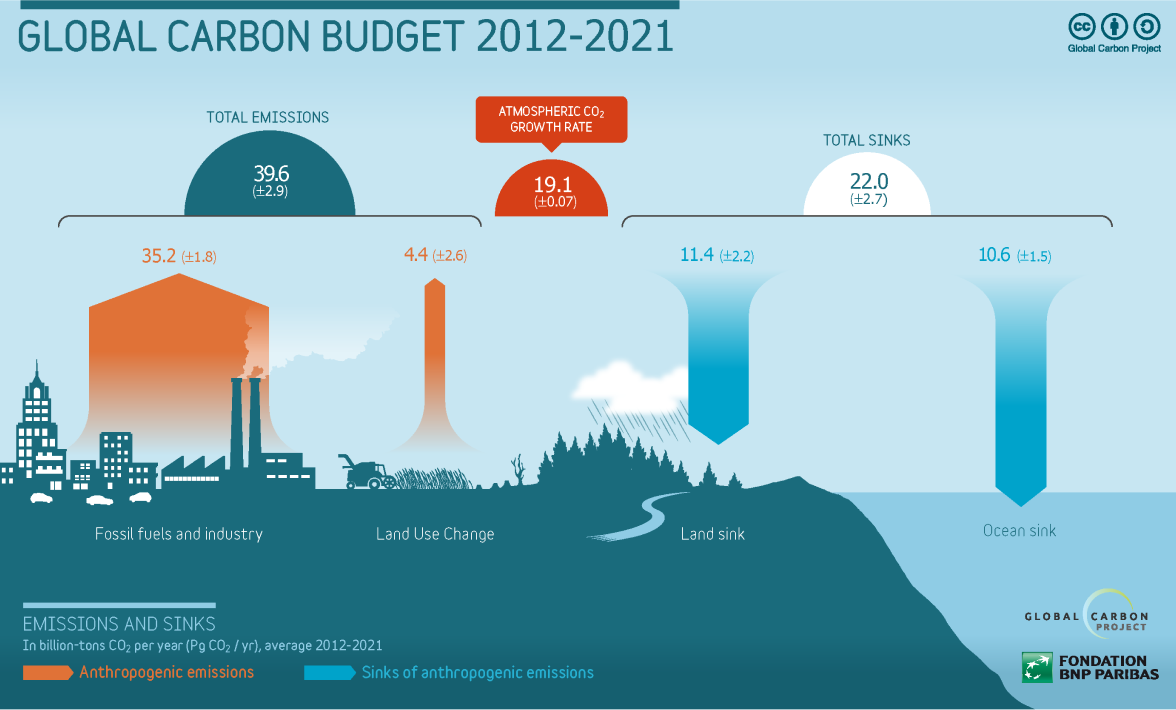Data source: Friedlingstein et al. 2022 Global Carbon Budget 2022. Earth System Science Data.
Importance:
CO₂ is the single most important greenhouse gas leading to human-induced climate change. Although other GHGs are more powerful per molecule in warming the planet than CO₂, the sheer amount of CO₂ emissions from human activities and the fact that some of the emissions stay in the atmosphere for hundreds to thousands of years, makes CO₂ the biggest challenge in combating climate change.
Atmospheric concentrations of CO₂ reached 407 parts per million in 2018, about 46% higher than pre-industrial levels, and the highest concentration in the last 800,000 years and probably in the last 2 million years. Equally unprecedented is the speed at which CO₂ has accumulated in the atmosphere during the Industrial Era at about 10 times faster than any time in the past 66 million years.
The carbon budget:
The carbon budget as described here, refers to the budget of all emissions and removals of CO₂ which are the direct or indirect result of human activities. The biggest component of this human perturbation is the emissions from the combustion of fossil fuels (coal, oil and gas) which accounts for almost 90% of all CO₂ emissions, and includes a small component from the production of cement. The rest of emissions come from land use change (eg. deforestation).
Lucky for us, of all CO₂ emitted to the atmosphere only about half remains in the atmosphere and leading to climate change, the other half is removed by the CO₂ sinks on land (vegetation uptake through photosynthesis) and oceans (thru diffusion). This way, the impact on climate change is only half of what would be, had not been for the help of those natural CO₂ sinks. That is why is so important we monitor, understand, and predict the evolution of the CO₂ sinks so we know how fast climate change will occur and by how much.
Estimating the carbon budget:
The Global Carbon Project has established a consortium of more than 50 research institutions around the world to gather the observations, statistics and run global models to update and improve the carbon budget every year. This requires to gather national and global statistics of energy consumption, industrial production, changes in land use change, fire spread, atmospheric and ocean CO₂ concentrations, and lots of climate data to be able to run dozens of models to estimate, independently, each of the major CO₂ sources and sinks.
Uncertainties:
Not all the CO₂ fluxes are known equally well, and although the global totals are known best, attempts to understand the regional contributions for each flux remains uncertain. We do know quite well the fossil fuel emissions all the way to the national level. CO₂ fluxes from land use change are the most uncertain and the consortium of scientists is making every effort possible to improve it. There is also variability of these fluxes at the annual and decadal scales for which we understand some of their drivers but not all. However, the long-term trends are better known and are the most important trends for understanding and predicting climate change.
Future work:
As part of its scientific goals, the Global Carbon Project team will further develop more complete and better constrained carbon budgets with annual updates. For further information visit: https://www.globalcarbonproject.org/carbonbudget


